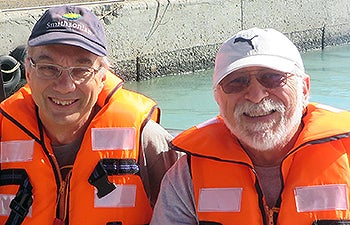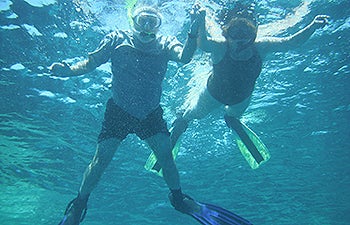Plunging into the Red Sea
Sailing across the Red Sea, USC Dornsife’s Douglas Capone and Linda Duguay hoped to get an up-close view of the reddish blooms created by cyanobacteria, which give the water its distinctive, eponymous hue.
“The Red Sea is a phenomenal environment,” said Capone, William and Julie Wrigley Chair in Environmental Studies and professor and chair of biological sciences at USC Dornsife. “It’s one of the warmest and saltiest bodies of water on Earth, but the amount of oceanographic research performed there has been very limited because of political and jurisdictional issues.”
That is about to change. Capone, and Duguay, director of research for the Wrigley Institute and director of the USC Sea Grant Program, traveled to Saudi Arabia in March at the invitation of former USC Dornsife professor Burton Jones, now professor of marine sciences at King Abdullah University of Science and Technology (KAUST).
Microbiologists and phytoplankton ecologists, Capone and Jones — a member of KAUST’s recently launched Red Sea Research Center and Director of the ARAMCO Center — are spearheading a collaborative research project between USC Dornsife and the new Saudi Arabian university. The project will focus on aspects of the fundamental ecology of the Red Sea.
KAUST will provide USC over $400,000 in support for the next three years to participate in the collaborative research program. This will include members of the Capone laboratory joining several research cruises on the new state-of-the-art marine research vessel at KAUST, the R.V. Thuwal. The overall effort will contribute to the development of a comprehensive research program to understand the fundamentals of nutrient dynamics in the Red Sea. The intention is to develop an ongoing and longer term collaboration between the Saudi Arabian university and USC.
“Personally, I’m very excited to have this opportunity to study a virgin ecosystem — at least from a research perspective,” Capone said.

Capone (right) with former USC Dornsife professor Burton Jones, now professor of marine sciences at KAUST and a member of its Red Sea Research Center.
Located in the Saudi Arabian desert on the eastern shore of the Red Sea at Thuwal, KAUST is approximately 80 kilometers north of the major Saudia Arabian city of Jeddah. This unique research university was inaugurated in 2009, and is an oasis of graduate learning devoted to biology, environmental sciences, mathematics and engineering. KAUST is headed by the former president of the California Institute of Technology, Jean-Lou Chameau.
The first joint research cruise will take place in October when two senior research associates from Capone’s laboratory will travel to Saudi Arabia to conduct experiments to determine important food chain processes, including rates of primary production, nitrogenous nutrient uptake and nitrogen fixation.
The research effort aims to gain an understanding of the nutrients dynamics within the Red Sea and the importance of dust input to this ecosystem.
“The Red Sea is surrounded by desert. Dust transport is an important pathway bringing nutrients such as iron and phosphate into this system,” he said. “We want to find out what nutrients limit coastal food webs and specifically if they are limited by the relative availability of nitrogen, phosphorus or iron. We also want to find out whether the Red Sea plays an important role in fertilizing adjacent areas such as the Gulf of Aden and the Arabian Sea.”
The research collaboration with KAUST is a homecoming of sorts for Capone. One focus of the project will be Trichodesmium, or sea sawdust, a cosmopolitan cyanobacteria found throughout nutrient poor tropical and subtropical ocean waters. It was first described in 1892 from a sample collected from the Red Sea by the German phycologist Ehrenberg. Charles Darwin and Joseph Banks, botanist with Captain Cook, both reported Trichodesmium’s presence on their cruises through the tropical Pacific Ocean.
Importantly, Trichodesmium fixes atmospheric nitrogen into ammonium, making it usable for other organisms.
“This organism is iconic for Doug,” said Duguay who is married to Capone. “He’s been following it since he was in graduate school, so to be able to study it in the Red Sea where it was first discovered is like coming full circle.”

Capone and Duguay, who are married, explore the waters of the Red Sea during a diving expedition. The collaborative research project will focus on the fundamental ecology of the Red Sea.
The Red Sea is also home to many beautiful coral reefs that have existed there for more than 10,000 years. Often called “rainforests of the sea,” coral reefs form some of the most diverse ecosystems on Earth. They occupy less than 0.1 percent of the world’s ocean surface, about half the area of France, yet they provide a home for 25 percent of all marine species.
“Coral reefs are endangered worldwide because of rising temperatures and yet the coral reefs in the Red Sea are surprisingly robust, given the naturally high temperatures and salinity there,” Duguay said. “We hope they might offer some key information to how we could help preserve other reefs around the world.”
The research collaboration will focus on two of the four persistent Red Sea gyres using robotic gliders brought to USC and deployed by Jones in the Southern California Bight while he was at USC Dornsife.
“These gyres are large scale circulation features in the Red Sea. In the northern hemisphere, cyclonic eddies result in nutrient enrichment of surface waters while anticyclonic eddies are nutrient poor. We will be initially examining the two nutrient poor anticyclonic eddies in the central Red Sea,” Capone said. “Burt’s team will be mapping the physical structure of these two eddies upon which we can then overlay the gradients of plant density and primary production we observe. In the long term, we will be providing fundamental information on how productive the coastal ecosystems of Saudi Arabia are and thereby what the potential may be for developing fisheries resources and aquaculture.”
“We have a very strong marine biology program at USC Dornsife and that, coupled with the overall stature of USC and the diversity of its programs, is very attractive to institutions such as KAUST,” Capone continued. “This international collaboration will provide KAUST with complementary expertise in marine ecosystems ecology as well as creating a vehicle for valuable cultural and scientific exchanges.”